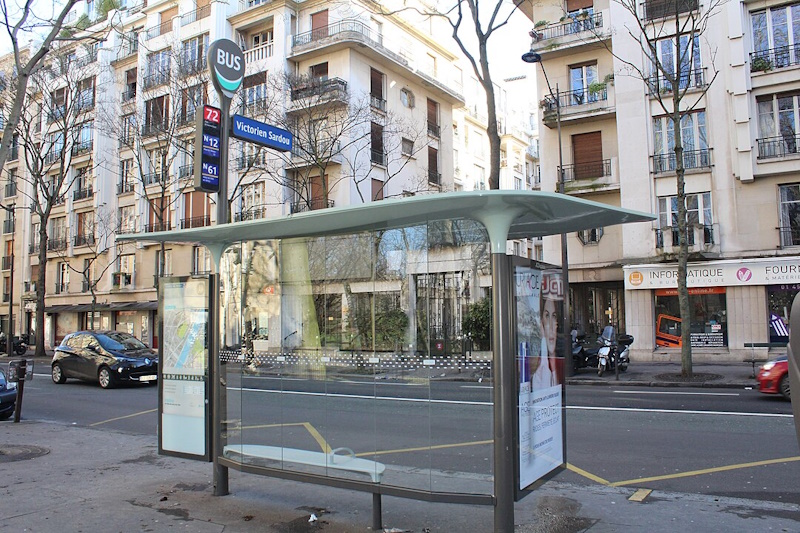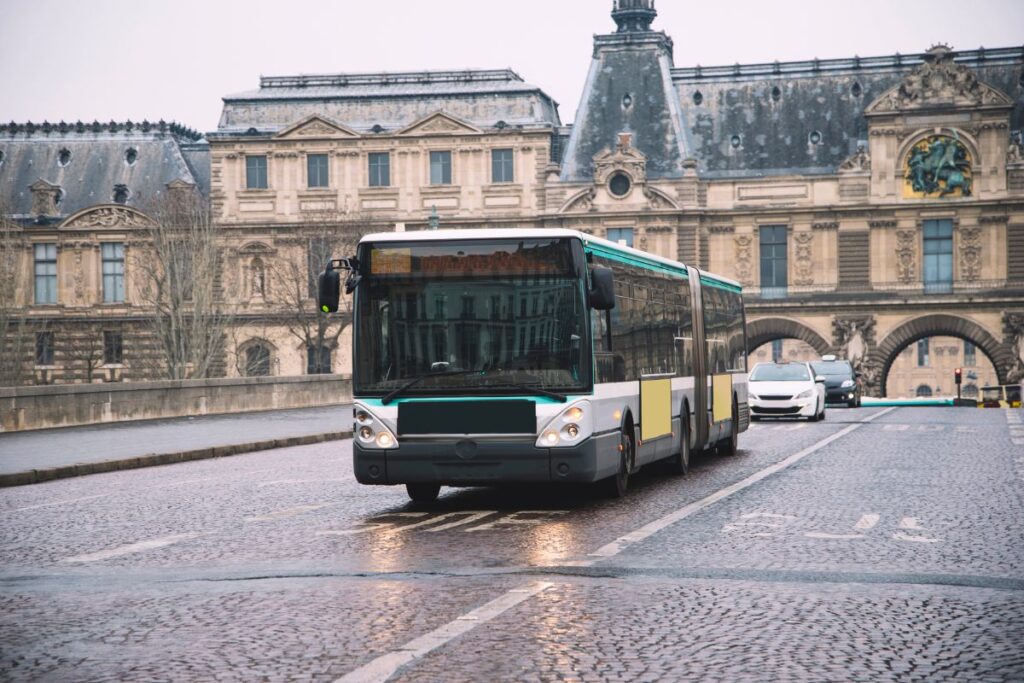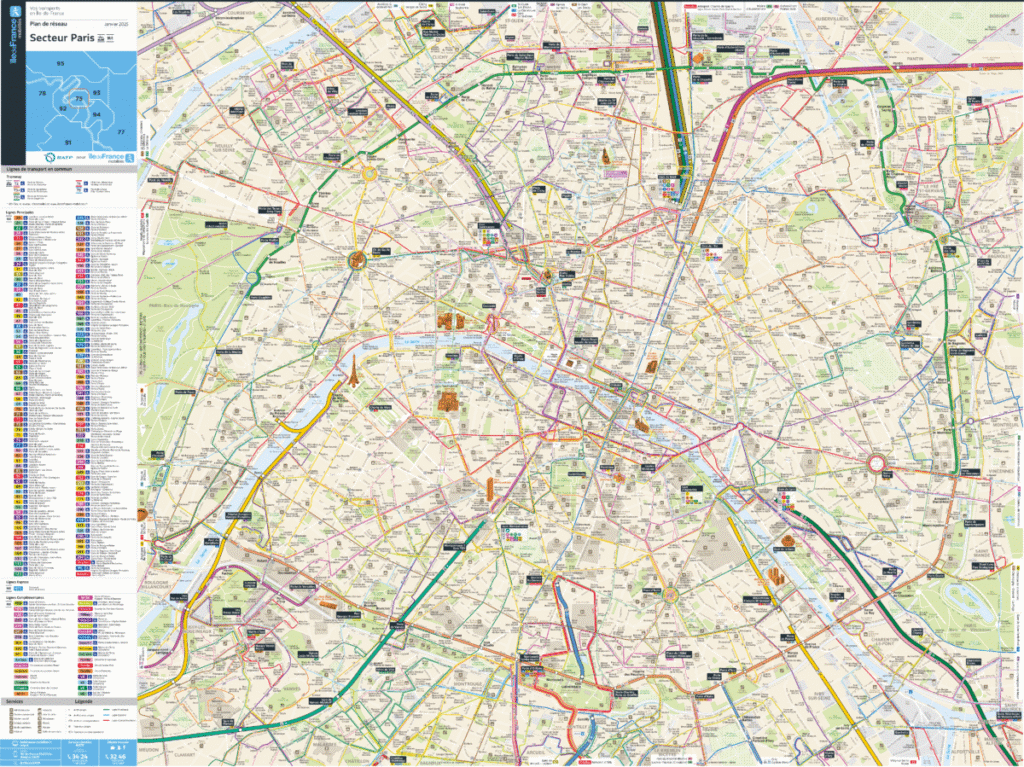Paris Bus Map + 15 Essential Tips for Using Paris Buses
Paris buses are overlooked by many tourists. But once you figure them out, they’re often easier, cheaper, and more scenic than the Metro.
Below is the Paris bus map for you to download as PDF. Below, you’ll also find a list of smart tips that don’t show up in guidebooks but can make or break your experience!
Paris Bus Map
Here are some helpful tips for using the bus system in the best way:
1. Board at the front only

All passengers enter through the front door and validate their ticket right by the driver. If you try to board in the middle or back, you’ll either be blocked or get looks. If you’re using a paper ticket, it needs to be validated in the little yellow machine.
2. You have to press the stop button
The bus won’t automatically stop just because someone is waiting near the exit. If no one presses the red “Arrêt demandé” button, it keeps going, even if you’re standing at the door.
3. Doors won’t reopen
Once the doors are shut, they stay shut. If you’re just a few steps away waving frantically, the driver generally won’t reopen. In fact, they may deliberately avoid eye contact to stick to the schedule.
4. Full buses skip stops
This happens often on popular lines during peak hours. If the bus is packed and the driver decides there’s no room, they won’t stop at all. The next one might or might not stop.
5. Metro tickets work – but not for transfers

A regular Metro ticket lets you board one bus. But you can’t transfer to another bus or switch to the Metro afterward. It’s valid for 90 minutes, but only within the bus/tram network, and only with proper validation (in the machine).
6. You CAN’T pay with cash
Forget handing the driver coins or bills. Most buses now only accept contactless payment (with a phone or card), a Navigo pass, or a pre-loaded ticket. If you’re not prepared, you may have to wait for the next bus.
7. Stop names are often vague
Many stops are named after cross streets, random monuments, or squares. Don’t assume you’ll see “Louvre” or “Notre-Dame” on the map. You need to know the exact stop name for your destination or you might miss it entirely.
8. Arrival screens aren’t always reliable

The digital displays at stops are sometimes helpful – but sometimes not. When traffic is heavy, the times often freeze or jump around. Don’t rely on them too much for tight schedules.
9. Buses get stuck in traffic

Unlike the Metro, buses share the road with everyone else. Some major routes, especially in the Marais or near Montparnasse, are notoriously slow in the afternoon. If you’re in a rush, check the RATP app first.
10. Schedules vary a lot
There’s no consistent end time like the Metro. Some lines stop running around 9 PM. Others go till midnight. Always check your specific line. Google Maps isn’t always accurate for last buses, use the Bonjour RATP app instead.
Paper schedules are generally displayed at bus stops, but only for the lines that stop there.
11. Interior maps and announcements can be missing

Most buses have digital screens and audio to show upcoming stops, but it’s not guaranteed. If you don’t hear or see anything, follow along on your phone using GPS so you don’t miss your stop.
12. Buses are best for short trips
Local Parisians often use the bus for 3-6 stop rides. Tourists trying to cross the entire city on one bus usually get frustrated. If your ride takes more than 20 minutes, there’s probably a faster option.
13. Don’t expect the driver to speak English
Some might, but most don’t. And they’re not trained for tourist help. They’ll expect you to know where you’re going and get on quickly. Don’t count on asking for directions mid-ride.
14. Some routes are amazing for sightseeing

Line 42 goes from the Eiffel Tower to Opéra. Line 69 passes the Seine, Hôtel de Ville, the Louvre, and the Eiffel Tower. Line 38 crosses the Latin Quarter. For the price of a Metro ticket, you get a better view than most bus tours.
15. Each line has a different stop location
At big hubs like Bastille or République, each bus line may stop at a different pole or shelter, sometimes a block away. Look carefully at the line number and direction sign before waiting.
16. Night stops may be by request only
Between midnight and 5:30 AM, buses on the Noctilien night network only stop if you’ve pressed the button in advance. If you don’t, they’ll roll right past.
17. Not every bus is accessible
While most newer buses have ramps, many older ones don’t. And even with ramps, some drivers won’t deploy them unless asked directly. If you need one, board early and speak up.
18. Download Bonjour RATP
This is the official app for real-time updates on Metro, bus, RER, and tram. It’s far more reliable than Google Maps for Paris transit. You can enter your address and see which bus or Metro line is fastest in real time.
19. You’re not expected to talk but basic manners matter
It’s normal to ride in silence. Still, a quick “bonjour” when boarding and “merci, au revoir” when getting off is common courtesy. Drivers notice and appreciate it.
20. You’ll understand Paris geography better
Unlike the Metro, which hides the city, buses show you how places connect above ground. After a couple of bus rides, you’ll start understanding how neighborhoods fit together. That’s hard to get underground.


